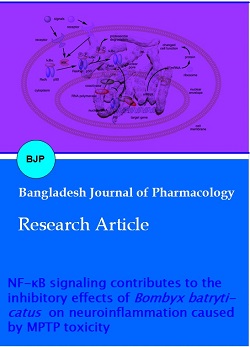NF-κB signaling contributes to the inhibitory effects of Bombyx batryticatus on neuroinflammation caused by MPTP toxicity
DOI:
https://doi.org/10.3329/bjp.v16i3.53611Abstract
Bombyx batryticatus, the dried larvae of Bombyx mori infected by Beauveria bassiana, is a renowned traditional medicine. Previous report shows that B. batryticatus improved behavioral impairments, protected dopaminergic neurons, and maintained dopamine levels by inhibiting oxidative signaling in murine Parkinson’s disease model. In this study, the inhibitory effects of B. batryticatus on 1-methyl 4-phenyl 1,2,3,6-tetrahydropyridine (MPTP)-induced Parkinson’s disease in mice was investigated and explored the corresponding molecular mechanisms, while focusing on NF-κB signaling. Consequently, it was found that B. batryticatus inhibited glial and microglial activation and the levels of neuroinflammatory mediators, such as Cox-2, iNOS, and NF-kB, in the substantia nigra pars compacta. Moreover, pre-inhibition of NF-κB by BAY 11-7082, a κB kinase inhibitor, could neutralize the inhibitory effects of B. batryticatus against the activation of glia and microglia formerly induced by MPTP. It can be considered that B. batryticatus holds implications in providing anti-inflammatory neuroprotection by regulating NF-κB signaling.
Downloads
253
192
References
Amor S, Puentes F, Baker D, Van Der Valk P. Inflammation in neurodegenerative diseases. Immunology 2010; 129: 154-69.
Baby N, Patnala R, Ling E-A, Dheen S. Nanomedicine and its application in treatment of microglia-mediated neuroinflammation. Curr Med Chem. 2014; 21: 4215-26.
Block ML, Zecca L, Hong J-S. Microglia-mediated neurotoxicity: Uncovering the molecular mechanisms. Nat Rev Neurosci. 2017; 8: 57-69.
Fakhoury M. Role of immunity and inflammation in the pathophysiology of neurodegenerative diseases. Neurodegener Dis. 2015; 15: 63-69.
Hu M, Liu Y, He L, Yuan X, Peng W, Wu C. Antiepileptic effects of protein-rich extract from Bombyx batryticatus on mice and its protective effects against H2O2-induced oxidative damage in PC12 cells via regulating PI3K/Akt signaling pathways. Oxidative medicine and cellular longevity. 2019, 2019.
Hu M, Yu Z, Wang J. Traditional uses, origins, chemistry and pharmacology of Bombyx batryticatus: A review. Molecules 2017; 22: 1779.
Kim ME, Park PR, Na JY, Jung I, Cho JH, Lee JS. Anti-neuroinflammatory effects of galangin in LPS-stimulated BV-2 microglia through regulation of IL-1β production and the NF-κB signaling pathways. Mol Cell Biochem. 2019; 451: 145-53.
Kim YS, Kim JS, Kwon JS. BAY 11-7082, a nuclear factor-κB inhibitor, reduces inflammation and apoptosis in a rat cardiac ischemia-reperfusion injury model. Int Heart J. 2015; 51: 348-53.
Kohno M, Link J, Dennis LE, McCready H, Huckans M, Hoffman WF, Loftis JM. Neuroinflammation in addiction: A review of neuroimaging studies and potential immunotherapies. Pharma Biochem Behav. 2019; 179: 34-42.
Kumar A, Negi G, Sharma SS. Suppression of NF-κB and NF-κB regulated oxidative stress and neuroinflammation by BAY 11-7082 (IκB phosphorylation inhibitor) in experimental diabetic neuropathy. Biochimie 2012; 94: 1158-65.
Lee S-H, Suk K. Emerging roles of protein kinases in microglia-mediated neuroinflammation. Biochem Pharmacol. 2017; 46: 1-9.
Lim H-S, Kim J-S, Moon BC, Ryu SM, Lee J, Park G. Batryticatus bombyx protects dopaminergic neurons against MPTP-induced neurotoxicity by inhibiting oxidative damage. Antioxidants 2019; 8: 574.
Park SY, Ahn SH, Kim HH. Effects of Fructus amomi Amari, Eucommiae cortex, Bombyx batryticatus extract on improving symptoms of late-onset hypogonadism. J Physiol Pathol Korean Med. 2019; 33: 89-101.
Park G, Lee SH, Oh DS, Kim YU. Melatonin inhibits neuronal dysfunction‐associated with neuroinflammation by atopic psychological stress in NC/Nga atopic‐like mouse models. J Pineal Res. 2017; 63: e12420.
Pyo JS, Kim HH, Kim KM, Kang JS. Amelioration of dry eye syndrome by oral administration of cultivated wild ginseng extract. Bangladesh J Pharmacol. 2019; 14: 61-66.
Sardi SP, Cedarbaum JM, Brundin P. Targeted therapies for Parkinson's disease: From genetics to the clinic. Mov Disord. 2018; 33: 684-96.
Schain M, Kreisl WC. Neuroinflammation in neurodegenerative disorders: A review. Curr Neurol Neurosci Rep. 2017; 17: 25.
Seppi K, Ray Chaudhuri K, Coelho M, Fox SH, Katzenschlager R, Perez Lloret S, Weintraub D, Sampaio C, collaborators of the Parkinson's Disease Update on Non‐Motor Symptoms Study Group on behalf of the Movement Disorders Society Evidence‐Based Medicine Committee, Chahine L, Hametner EM. Update on treatments for nonmotor symptoms of Parkinson's disease: An evidence‐based medicine review. Mov Disord. 2019; 34: 180-98.
Singh SS, Rai SN, Birla H, Zahra W, Rathore AS, Singh SP. NF-κB-mediated neuroinflammation in Parkinson’s disease and potential therapeutic effect of polyphenols. Neurotox Res. 2020; 37: 491-507.
Stephenson J, Nutma E, van der Valk P, Amor S. Inflammation in CNS neurodegenerative diseases. Immunology 2018; 154: 204-19.
Subhramanyam CS, Wang C, Hu Q, Dheen ST Microglia-mediated neuroinflammation in neurodegenerative diseases. In: Seminars in cell & developmental biology. Vol 94. Elsevier, 2019, pp 112-20.

Downloads
Published
Versions
- 2021-08-05 (2)
- 2021-08-05 (1)
How to Cite
Issue
Section
License
Copyright (c) 2021 Hye-Sun Lim, Yumi Jang, Byeong Cheol Moon, Gunhyuk Park

This work is licensed under a Creative Commons Attribution 4.0 International License.
Authors who publish with this journal agree to the following terms:
- Authors retain copyright and grant the journal right of first publication with the work simultaneously licensed under a Creative Commons Attribution License that allows others to share the work with an acknowledgement of the work's authorship and initial publication in this journal.
- Authors are able to enter into separate, additional contractual arrangements for the non-exclusive distribution of the journal's published version of the work (e.g., post it to an institutional repository or publish it in a book), with an acknowledgement of its initial publication in this journal.
- Authors are permitted and encouraged to post their work online (e.g., in institutional repositories or on their website) prior to and during the submission process, as it can lead to productive exchanges, as well as earlier and greater citation of published work (See The Effect of Open Access).
